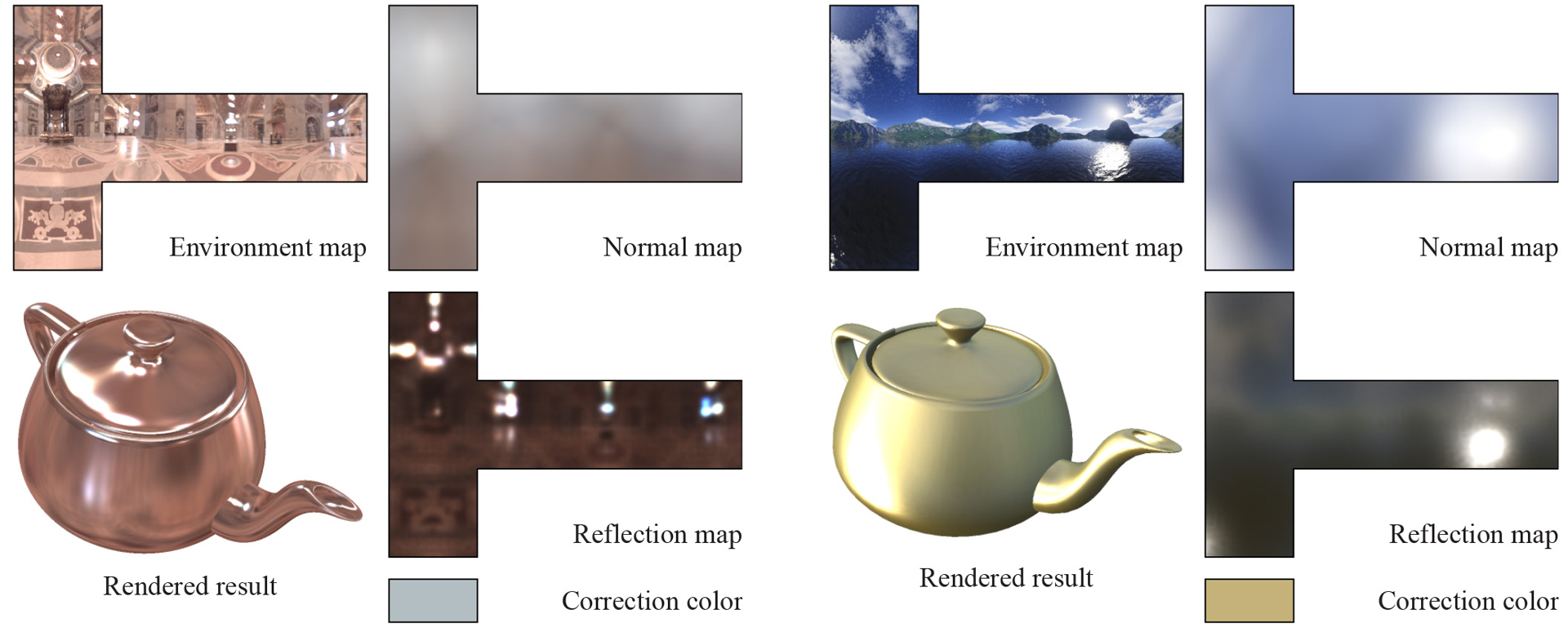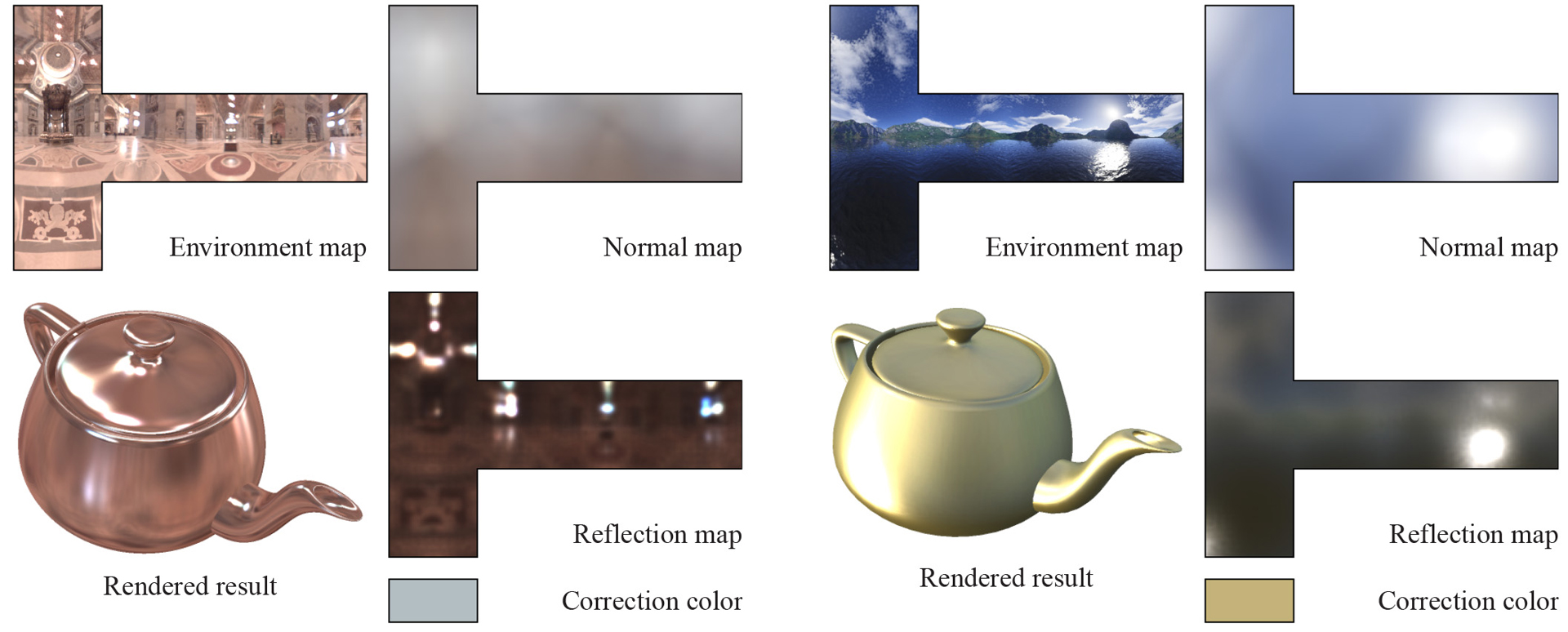“Homomorphic factorization of BRDF-based lighting computation” by Latta and Kolb
Conference:
Type(s):
Title:
- Homomorphic factorization of BRDF-based lighting computation
Presenter(s)/Author(s):
Abstract:
Several techniques have been developed to approximate Bidirectional Reflectance Distribution Functions (BRDF) with acceptable quality and performance for realtime applications. The recently published Homomorphic Factorization by McCool et al. is a general approximation approach that can be used with various setups and for different quality requirements.In this paper we propose a new technique based on the Homomorphic Factorization. Instead of approximating the BRDF, our technique factorizes the full lighting computation of an isotropic BRDF in a global illumination scenario. With this method materials in complex lighting situations can be simulated with only two textures by using commonly available computation capabilities of current graphics hardware.The new technique can also be considered as a generalized approach to several environment map prefiltering techniques. Existing prefiltering techniques are usually limited to specific BRDFs or require advanced hardware capabilities like 3D texturing. With the factorization only common 2D textures are required.
References:
1. BANKS, D. 1994. Illumination in diverse codimensions. In ACM Proceedings SIGGRAPH, Addison Wesley, vol. 28, ACM, 327-334. Google Scholar
2. CABRAL, B., OLANO, M., AND NEMEC, P. 1999. Reflection space image based rendering. In ACM Proceedings SIGGRAPH, Addison Wesley, vol. 33, ACM, 165-170. Google Scholar
3. CHEN, W.-C., GRZESZCZUK, R., AND BOUGUET, J.-Y. 2001. Light field mapping: Hardware-accelerated visualization of surface light fields. In SIGGRAPH 2001 Course Notes “Acquisition and Visualization of Surface Light Fields”.Google Scholar
4. COOK, R., AND TORRANCE, K. 1981. A reflectance model for computer graphics. In ACM Proceedings SIGGRAPH, Addison Wesley, vol. 15, ACM, 307-316. Google Scholar
5. CORNELL UNIVERSITY, 2002. Program of computer graphics online resource: Reflectance data. http://www.graphics.cornell.edu/online/measurements/reflectance/index. html.Google Scholar
6. DEBEVEC, P., 2002. Online resources. http://www.debevec.org.Google Scholar
7. FOURNIER, A. 1992. Filtering normal maps and creating multiple surfaces. Tech. Rep. TR-92-41, Department of Computer Science, University of British Columbia, Vancouver, BC, Canada. Google Scholar
8. FOURNIER, A. 1992. Normal distribution functions and multiple surfaces. In Proc. Graphics Interface, Workshop on Local Illumination, Morgan Kaufmann, Canadian Human-Computer Communications Society, 45-52.Google Scholar
9. FOURNIER, A. 1995. Separating reflection functions for linear radiosity. In EUROGRAPHICS Rendering Workshop, Eurographics, 296-305. Google Scholar
10. FREUND, R. W., AND NACHTIGAL, N. M. 1992. QMR: a quasi-minimal residual method for non-Hermitian linear systems. In Iterative Methods in Linear Algebra, R. Beauwens and P. de Groen, Eds. Elsevier Science Publishers, 151-154.Google Scholar
11. HEIDRICH, W., AND SEIDEL, H.-P. 1998. View-independent environment maps. In Eurographics/SIGGRAPH Workshop on Graphics Hardware, Addison-Wesley, 39-45. Google Scholar
12. HEIDRICH, W., AND SEIDEL, H.-P. 1999. Realistic, hardware-accelerated shading and lighting. In ACM Proceedings SIGGRAPH, Addison Wesley, vol. 33, ACM, 171-178. Google Scholar
13. KAUTZ, J., AND McCOOL, M.-D. 1999. Hardware rendering with bidirectional reflectances. Tech. rep., Department of Computer Science, University of Waterloo.Google Scholar
14. KAUTZ, J., AND MCCOOL, M.-D. 1999. Interactive rendering with arbitrary BRDFs using separable approximations. In EUROGRAPHICS Rendering Workshop, Eurographics, 253-253. Google Scholar
15. KAUTZ, J., AND McCOOL, M. D. 2000. Approximation of glossy reflection with prefiltered environment maps. In Proc. Graphics Interface, Morgan Kaufmann, Canadian Human-Computer Communications Society, 119-126. Google Scholar
16. KAUTZ, J., VAZQUEZ, P., HElDRICH, W., AND SEIDEL, H.-P. 2000. A unified approach to prefiltered environment maps. In EUROGRAPHICS Rendering Workshop, Eurographics, 185-196. Google Scholar
17. LAFORTUNE, E. P., AND WILLEMS, Y. D. 1994. Using the modified phong BRDF for physically based rendering. Tech. Rep. CW197, Dept. of Computer Science, Leuven, Belgium.Google Scholar
18. LAFORTUNE, E., FOO, S.-C., TORRANCE, K., AND GREENBERG, D. 1997. Non-linear approximation of reflectance functions. In ACM Proceedings SIGGRAPH, Addison Wesley, vol. 31, ACM, 117-126. Google Scholar
19. LEVOY, M., AND HANRAHAN, P. 1996. Lightfield rendering. In ACM Proceedings SIGGRAPH, Addison Wesley, vol. 30, ACM, 31-42. Google Scholar
20. LINDHOLM, E., KILGARD, M., AND MORETON, H. 2001. A user-programmable vertex engine. In ACM Proceedings SIGGRAPH, Addison Wesley, vol. 35, ACM. Google Scholar
21. McCOOL, M.-D., ANG, J., AND AHMAD, A. 2001. Homomorphic factorization of BRDFs for high-performance rendering. In ACM Proceedings SIGGRAPH, Addison Wesley, vol. 35, ACM, 171-178. Google Scholar
22. MILLER, G., AND HOFFMAN, R. 1984. Illumination and reflection maps: Simulated objects in simulated and real environments. In SIGGRAPH 1984 Course Notes “Advanced Computer Graphics Animation”.Google Scholar
23. PHONG, B. T. 1975. Illumination for computer generated pictures. Communications of the ACM 18, 6, 311-317. Google Scholar
24. SGI, 2002. OpenGL extension registry. http://oss.sgi.com/projects/ogl-sample/registry.Google Scholar





